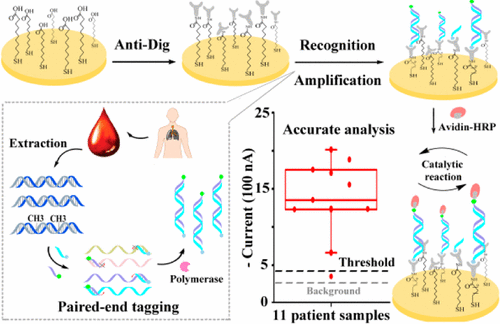当前位置:
X-MOL 学术
›
Anal. Chem.
›
论文详情
Our official English website, www.x-mol.net, welcomes your
feedback! (Note: you will need to create a separate account there.)
Accurate Electrochemistry Analysis of Circulating Methylated DNA from Clinical Plasma Based on Paired-End Tagging and Amplifications
Analytical Chemistry ( IF 6.7 ) Pub Date : 2017-09-11 00:00:00 , DOI: 10.1021/acs.analchem.7b02572 Feng Chen 1 , Xuyao Wang 1 , Xiaowen Cao 1 , Yongxi Zhao 1
Analytical Chemistry ( IF 6.7 ) Pub Date : 2017-09-11 00:00:00 , DOI: 10.1021/acs.analchem.7b02572 Feng Chen 1 , Xuyao Wang 1 , Xiaowen Cao 1 , Yongxi Zhao 1
Affiliation

|
Circulating methylated DNA has been a new kind of cancer biomarker, yet its small fraction of trace total DNA from clinical samples impairs the accurate analysis. Though fluorescence methods based on quantitative methylation specific PCR (qMSP) have been adopted routinely, yet alternative electrochemistry assay of such DNA from clinical samples remains a great challenge. Herein, we report accurate electrochemistry analysis of circulating methylated DNA from clinical plasma samples based on a paired-end tagging and amplifications strategy. Two DNA primers each labeled with digoxigenin (Dig) and biotin are designed for the recognition and amplification of methylated DNA. Paired-end tagging amplicons and avidin-HRP molecules are successively captured on the electrode modified with Anti-Dig. Then HRP executes catalytic reaction to generate amplified signal. The design of paired-end tagging can readily integrate downstream electrochemical amplified reaction, and two heterogeneous amplifications enable high assay sensitivity. As little as 40 pg of methylated genomic DNA (∼10 genomic equivalents) is well identified, and our strategy can even distinguish as low as 1% methylation level. Tumor-specific methylated DNA is clearly detected in the plasma of 10 of 11 NSCLC patients. The high clinical sensitivity of 91% (10/11) indicates the good consistency with clinical diagnosis. Excellent spatial control of electrochemistry allows simpler detection of more methylation patterns compared to fluorescence methods. The developed electrochemical assay is a promising liquid biopsy tool for the analysis of tumor-specific circulating DNA.
中文翻译:

基于双末端标记和扩增的临床血浆中循环甲基化DNA的准确电化学分析
循环甲基化DNA已成为一种新型的癌症生物标志物,但其来自临床样品的痕量总DNA中的一小部分会损害准确分析。尽管常规地采用了基于定量甲基化特异性PCR(qMSP)的荧光方法,但是临床样品中此类DNA的替代电化学分析仍然是一个巨大的挑战。在本文中,我们报告了基于配对末端标记和扩增策略的临床血浆样品中循环甲基化DNA的准确电化学分析。设计了两个分别用洋地黄毒苷(Dig)和生物素标记的DNA引物,用于识别和扩增甲基化DNA。配对末端的标记扩增子和抗生物素蛋白-HRP分子被依次捕获在用Anti-Dig修饰的电极上。然后HRP进行催化反应以产生放大的信号。配对末端标记的设计可轻松整合下游的电化学扩增反应,并且两个异质扩增可实现较高的测定灵敏度。可以准确识别出仅40 pg的甲基化基因组DNA(约10个基因组当量),我们的策略甚至可以区分低至1%的甲基化水平。在11例NSCLC患者中,有10例血浆中明显检测到了肿瘤特异性甲基化DNA。91%(10/11)的高临床敏感性表明与临床诊断的良好一致性。与荧光方法相比,出色的电化学空间控制可以更轻松地检测更多的甲基化模式。发达的电化学测定法是用于分析肿瘤特异性循环DNA的有前途的液体活检工具。配对末端标记的设计可轻松整合下游的电化学扩增反应,并且两个异质扩增可实现较高的测定灵敏度。可以准确识别出仅40 pg的甲基化基因组DNA(约10个基因组当量),我们的策略甚至可以区分低至1%的甲基化水平。在11例NSCLC患者中,有10例血浆中明显检测到了肿瘤特异性甲基化DNA。91%(10/11)的高临床敏感性表明与临床诊断的良好一致性。与荧光方法相比,出色的电化学空间控制可以更轻松地检测更多的甲基化模式。发达的电化学测定法是用于分析肿瘤特异性循环DNA的有前途的液体活检工具。配对末端标记的设计可轻松整合下游的电化学扩增反应,并且两个异质扩增可实现较高的测定灵敏度。可以准确识别出仅40 pg的甲基化基因组DNA(约10个基因组当量),我们的策略甚至可以区分低至1%的甲基化水平。在11例NSCLC患者中,有10例血浆中明显检测到了肿瘤特异性甲基化DNA。91%(10/11)的高临床敏感性表明与临床诊断的良好一致性。与荧光方法相比,出色的电化学空间控制可以更轻松地检测更多的甲基化模式。发达的电化学测定法是用于分析肿瘤特异性循环DNA的有前途的液体活检工具。
更新日期:2017-09-11
中文翻译:

基于双末端标记和扩增的临床血浆中循环甲基化DNA的准确电化学分析
循环甲基化DNA已成为一种新型的癌症生物标志物,但其来自临床样品的痕量总DNA中的一小部分会损害准确分析。尽管常规地采用了基于定量甲基化特异性PCR(qMSP)的荧光方法,但是临床样品中此类DNA的替代电化学分析仍然是一个巨大的挑战。在本文中,我们报告了基于配对末端标记和扩增策略的临床血浆样品中循环甲基化DNA的准确电化学分析。设计了两个分别用洋地黄毒苷(Dig)和生物素标记的DNA引物,用于识别和扩增甲基化DNA。配对末端的标记扩增子和抗生物素蛋白-HRP分子被依次捕获在用Anti-Dig修饰的电极上。然后HRP进行催化反应以产生放大的信号。配对末端标记的设计可轻松整合下游的电化学扩增反应,并且两个异质扩增可实现较高的测定灵敏度。可以准确识别出仅40 pg的甲基化基因组DNA(约10个基因组当量),我们的策略甚至可以区分低至1%的甲基化水平。在11例NSCLC患者中,有10例血浆中明显检测到了肿瘤特异性甲基化DNA。91%(10/11)的高临床敏感性表明与临床诊断的良好一致性。与荧光方法相比,出色的电化学空间控制可以更轻松地检测更多的甲基化模式。发达的电化学测定法是用于分析肿瘤特异性循环DNA的有前途的液体活检工具。配对末端标记的设计可轻松整合下游的电化学扩增反应,并且两个异质扩增可实现较高的测定灵敏度。可以准确识别出仅40 pg的甲基化基因组DNA(约10个基因组当量),我们的策略甚至可以区分低至1%的甲基化水平。在11例NSCLC患者中,有10例血浆中明显检测到了肿瘤特异性甲基化DNA。91%(10/11)的高临床敏感性表明与临床诊断的良好一致性。与荧光方法相比,出色的电化学空间控制可以更轻松地检测更多的甲基化模式。发达的电化学测定法是用于分析肿瘤特异性循环DNA的有前途的液体活检工具。配对末端标记的设计可轻松整合下游的电化学扩增反应,并且两个异质扩增可实现较高的测定灵敏度。可以准确识别出仅40 pg的甲基化基因组DNA(约10个基因组当量),我们的策略甚至可以区分低至1%的甲基化水平。在11例NSCLC患者中,有10例血浆中明显检测到了肿瘤特异性甲基化DNA。91%(10/11)的高临床敏感性表明与临床诊断的良好一致性。与荧光方法相比,出色的电化学空间控制可以更轻松地检测更多的甲基化模式。发达的电化学测定法是用于分析肿瘤特异性循环DNA的有前途的液体活检工具。











































 京公网安备 11010802027423号
京公网安备 11010802027423号